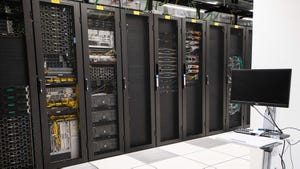Moody’s Report Reveals Surge in Data Center Demand Driven by AI BoomMoody’s Report Reveals Surge in Data Center Demand Driven by AI Boom
A new industry report forecasts a dramatic build-out of data centers over the coming years.

A new report from Moody’s Ratings highlights the dramatic increase in data center demand, primarily fueled by advancements in artificial intelligence (AI) and ongoing digital transformation.
The report, titled ‘Data Centers – Artificial Intelligence: Tech Giants’ Rapid Buildout of Data Centers to Meet AI Demand is Not Without Risk,’ provides insights into the current state and future projections of the global data center industry.
Among the report’s key findings:
Global data center capacity is expected to double over the next five years
Data center electricity consumption is forecast to grow by an average of 23% annually between 2023 and 2028
AI-specific data center energy usage is projected to grow by an average of 43% annually over the same period
Hyperscalers estimated to increase annual IT spending by $48 billion in 2024
The dramatic spike in data center growth was not unexpected to Moody’s. “We are not at all surprised by the impact of AI on data center capacity, as GPUs processing AI workloads require much higher power consumption compared to the traditional processors,” Raj Joshi, senior vice president for Moody’s Ratings, told Data Center Knowledge.
“The size of new AI models is growing rapidly and adoption rates of AI are very high, so we were surprised by the speed of AI adoption and the pace of technology innovation, which are driving the surge in data center infrastructure spending.”
Where All the Data Center Power is Going
The Moody’s report (registration required) notes that demand for data center capacity is surging due to the computational power needed for AI advancements and ongoing digital transformation.
Hyperscalers including Amazon, Google, Microsoft, and Meta are rapidly building and leasing new data center capacity to meet expected future demand, focusing on both space and power.
With AI there are two primary operations: ‘training’, where models are built and expanded over time, and ‘inference’, where existing models are used to derive a response.
According to Moody’s, considerably less computing resources are required for inferencing than training. However the report goes on to note that “inferencing is growing quickly and the volume of inferencing requests to data centers will grow substantially as usage of AI-powered applications expands with increasing adoption."
Moody’s said it expects that inferencing will grow to represent the vast majority of AI workloads over the next five years.
Cloud Repatriation is Not a Major Concern
Some reports, including recent insight from CoreSite, claim that cloud repatriation is a growing concern. Cloud repatriation however isn’t worrying Moody’s much, if at all.
“Repatriation of workloads from the cloud is not new but migration of workloads to the cloud far exceeds the repatriation volumes,” Joshi said. “This is evidenced by growth rates of hyperscalers, subdued growth rates of IT hardware infrastructure vendors that primarily serve the on-prem markets, and various third-party reports.”
Cloud Hyperscalers will Prioritize AI Investments
Moody’s isn’t the only group forecasting strong data center and cloud growth. A recent report from BlackRock also noted strong expectations for data center growth in the next few years.
Dell’Oro Group senior director Baron Fung has a nuanced view of how data center growth will persist.
“I agree that demand for traditional cloud services will continue to drive robust demand,” Fung told Data Center Knowledge.
Fung added that there was a bit of a correction cycle last year in which enterprise customers optimized their cloud usage. He noted that some cloud service providers, such as AWS, are now seeing more stability. However, looking ahead, he warned that the market should expect lower growth in cloud revenues for traditional services than was seen several years ago.
Overall, Fung expects that the growth rate will be in the robust double-digit annual growth range.
“Looking ahead, we should continue to see large enterprise customers move selective workloads to the public cloud, and SMBs will rely more on the public cloud,” Fung said. “However, the market is approaching an equilibrium point in which some amount of workloads will remain in private data centers on-premises, rather than the cloud.”
Fung also expects that cloud service providers will continue to prioritize AI investments over traditional IT investments through this year.
“It’s a lot of investment, and there may not be a return on investment for some time, but no one wants to be left behind,” Fung said. “First adopters tend to maintain a strong advantage, like Amazon did with the cloud around 10 years ago.”
About the Author
You May Also Like









